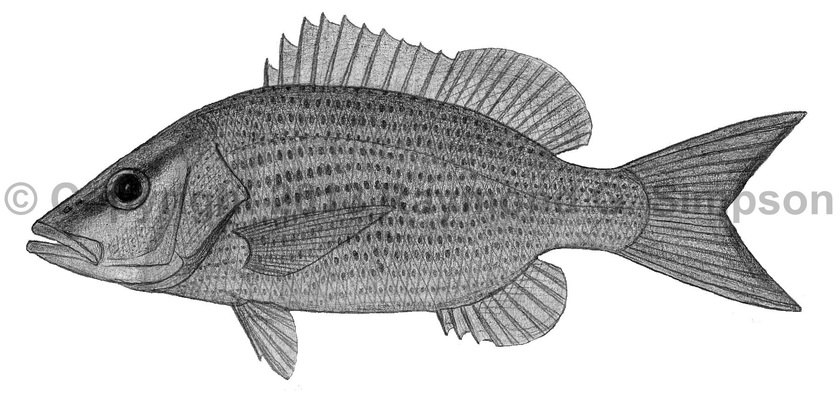
Common Name
Gray Snapper
Year Described
Linnaeus, 1758
Identification
Dorsal Fin: X, 14
Anal Fin: III, 7-8 (usually 8)
Pectoral Fin: 15-17
Gill Rakers: 6-8 upper, 12-14 lower; 18-22 total
Lateral Line Scales: 43-47
Body relatively deep (2.6-3.2 times in SL) and moderately compressed. Upper and lower jaws with a row of conical teeth. Anterior upper jaw teeth enlarged. Vomerine teeth in a anchor-shaped patch with a median extension. Palatine teeth an elongate band. Ectopterygoid teeth absent. Soft dorsal and anal fins with scales on membranes. Maxilla scaleless. No distinct notch between spiny and soft dorsal fins. Last dorsal ray not elongated. Soft dorsal fin rounded. Anal fin rounded. Pectoral fin equal to the distance from snout to preopercular margin (3.7-4.2 times in SL). Caudal fin emarginate or slightly forked.
Color
Body pale gray, occasionally with faint bronze or reddish tinges. Scale centers darker, giving the appearance of lighter reticulations. Young fish have a prominent dark eye-stripe and a blue stripe under eye that fades in adults. Dorsal and caudal fins darker gray with a dark margin. Anal and pelvic fins body colored with a yellowish tinge.
Size
Maximum size to 92cm TL. Commonly to 55cm TL.
Habitat
Found in a variety of habitats from coral reefs to offshore hard bottoms to estuaries (young). Depth range is 1-180m with older fish found in deeper water and juveniles in low salinity rivers and marshes. Often in large schools on reefs.
Range
Massachusetts to SE Brazil, including the Gulf of Mexico and the Caribbean Sea. Also Bermuda.
References
Anderson, W.D. 2002. Lutjanidae (pp. 1479-1504). In: Carpenter. 2002. The living marine resources of the Western Central Atlantic. Vol. 3: Bony fishes part 2 (Opistognathidae to Molidae). FAO Species Identification Guides for Fisheries Purposes. American Society of Ichthyologists and Herpetologists Special Publication No. 5. FAO of the U.N., Rome.